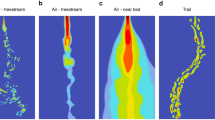Summary
-
1.
The postembryonic development of three identified ascending interneurones in the auditory system ofLocusta migratoria was studied using intracellular recording and staining techniques.
-
2.
The terminal arborisations in the brain of G, B and C neurones were identified in the adult, 5th and 4th instars, and for the G neurone in 3rd and 2nd instars as well (Figs. 2, 3). Further, the development of the soma and dendrites of the G neurone in the mesothoracic ganglion was followed from 2nd instar to adulthood (Fig. 4).
-
3.
The adult G, B and C neurones all terminate in the lower lateral lobe of the protocerebrum, and G and B neurones share a further projection area ventrally in the anterior protocerebrum (Fig. 2). The lower lateral protocerebrum may represent an auditory neuropil in the brain.
-
4.
The larval G, B and C neurones possess the general adult morphology throughout postembryonic development and neural growth is allometric. Only at the second instar level may some reduction in density of arborisation in brain and mesothoracic ganglion occur (Figs. 3, 4).
-
5.
The physiological responses of the identified adult and larval neurones are very similar. Expressed firstly as constant intensity curves (frequency response spectra) (Figs. 5, 6), the shapes of the adult spectra are seen reflected in larval G, B and C neurones throughout development. With each step back in development there is an accompanying loss in sensitivity which affects higher more than lower frequencies and is not always linearly related to age (Fig. 8). The thresholds obtained from second instar animals suggest that newly hatched (first instar) locusts are probably deaf to airborne sound.
-
6.
The intensity response and latency of response functions (Fig. 9 A) of the adult neurones are repeated in each larval instar studied; similarly the ipsilateral-contralateral difference characteristic of the B neurone is found intact in the 4th instar, although at a higher absolute intensity (Fig. 9B). These results suggest that the dynamic properties and synaptology described elsewhere for the adult neurones are already formed early in development. A role for these interneurones in the escape behaviour of the larva is considered.
Similar content being viewed by others
Abbreviations
- A :
-
Adult
- 5 :
-
5th instar
- 4 :
-
4th instar
- 3 :
-
3rd instar
- 2 :
-
2nd instar
- CNS :
-
Central Nervous System
- VNC :
-
Ventral Nerve Cord
- SPL :
-
Sound Pressure Level
References
Adam LJ (1969) Neurophysiologie des Hörens und Bioakustik einer Feldheuschrecke (Locusta migratoria). Z Vgl Physiol 63:227–289
Adam LJ, Schwartzkopff J (1967) Getrennte nervöse Repräsentation für verschiedene Tonbereiche im Protocerebrum vonLocusta migratoria. Z Vgl Physiol 54:246–255
Alexander RD (1967) Acoustical communication in Arthropods. Annu Rev Entomol 12:495–526
Popov AV (1965) Electrophysiological studies on the peripheral auditory neurons in the locust. J Evol Biochem Physiol 1: 239–250
Rehbein HG (1973) Experimentell-anatomische Untersuchungen über den Verlauf der Tympanalnervenfasern im Bauchmark von Feldheuschrecken, Laubheuschrecken und Grillen. Verh Dtsch Zool Ges 66:184–189
Rehbein H (1976) Auditory neurons in the ventral cord of the locust: morphological and functional properties. J Comp Physiol 110:233–250
Römer H (1976) Die Informationsverarbeitung tympanaler Rezeptorelemente vonLocusta migratoria (Acrididae, Orthoptera). J Comp Physiol 109:101–122
Römer H, Dronse R (1982) Synaptic mechanisms of monaural and binaural processing in the locust. J Insect Physiol 28:365–370
Römer H, Rheinlaender J, Dronse R (1981) Intracellular studies on auditory processing in the metathoracic ganglion of the locust. J Comp Physiol 144:305–312
Roonwal ML (1936) Studies on the embryology of the African migratory locust,Locusta migratoria migratorioides. I. The early development, with a new theory of multiphased gastrulation among insects. Philos Trans R Soc London Ser B 226:391–421
Shankland M (1981a) Development of a. sensory afferent projection in the grasshopper embryo. I. Growth of peripheral pioneer axons within the central nervous system. J Embryol Exp Morphol 64:169–185
Shankland M (1981b) Development of a sensory afferent projection in the grasshopper embryo. II. Growth and branching of peripheral sensory axons within the central nervous system. J Embryol Exp Morphol 64:187–209
Silver S, Kalmring K, Kühne R (1980) The responses of central acoustic and vibratory interneurones in bushcrickets and locusts to ultrasonic stimulation. Physiol Entomol 5:427–435
Simmons P (1980) A locust wind and ocellar brain neurone. J Exp Biol 85:281–294
Stewart WW (1978) Functional connections between cells as revealed by dye-coupling with a highly fluorescent naphthalimide tracer. Cell 14:741–759
Suga N (1960) Peripheral mechanism of hearing in locust. Jpn J Physiol 10:533–546
Whitington PM, Seifert E (1981) Identified neurons in an insect embryo: the pattern of neurons innervating the metathoracic leg of the locust. J Comp Neurol 200:203–212
Williams JLD (1975) Anatomical studies of the insect central nervous system: a ground-plan of the midbrain and an introduction to the central complex in the locust,Schistocerca gregaria (Orthoptera). J Zool 76:67–86
Author information
Authors and Affiliations
Rights and permissions
About this article
Cite this article
Boyan, G.S. Postembryonic development in the auditory system of the locust. J. Comp. Physiol. 151, 499–513 (1983). https://doi.org/10.1007/BF00605467
Accepted:
Issue Date:
DOI: https://doi.org/10.1007/BF00605467




